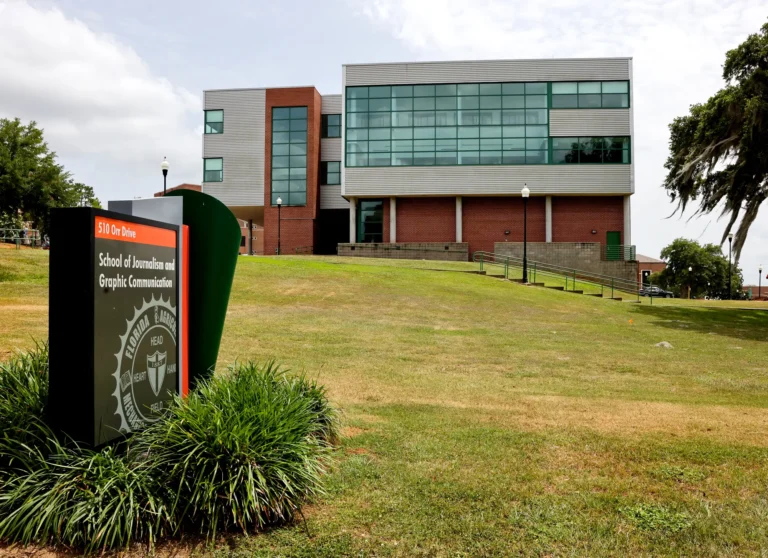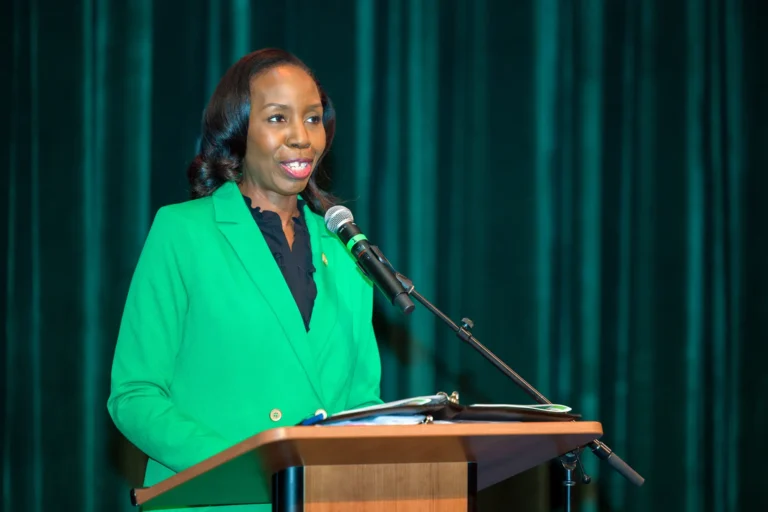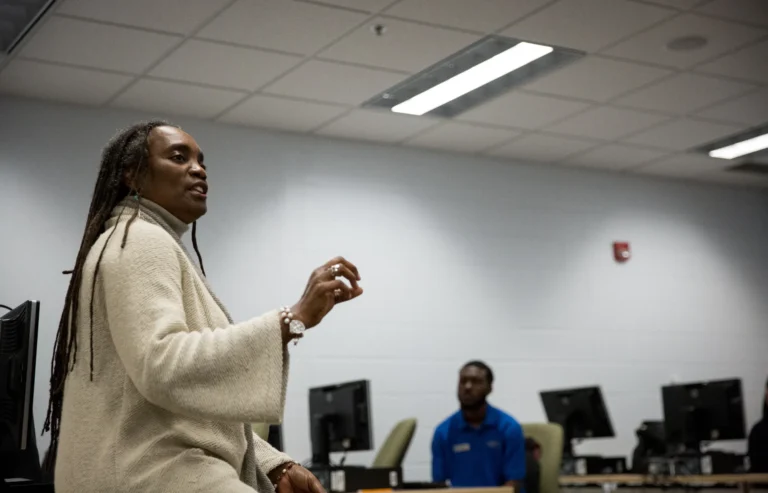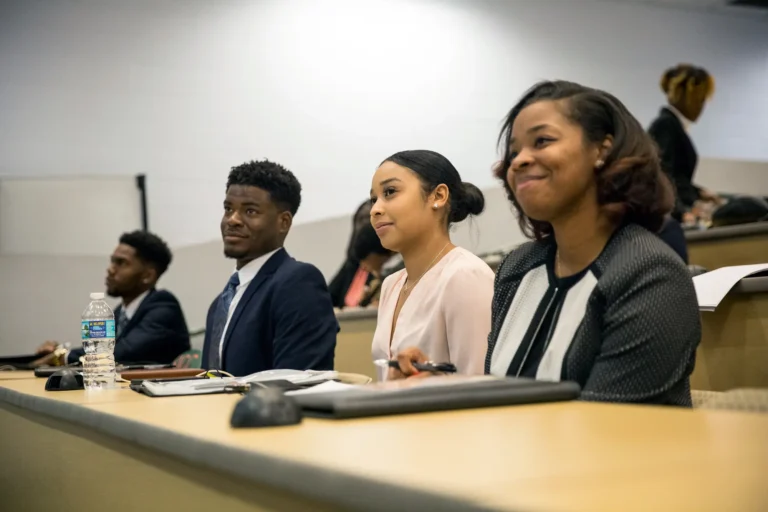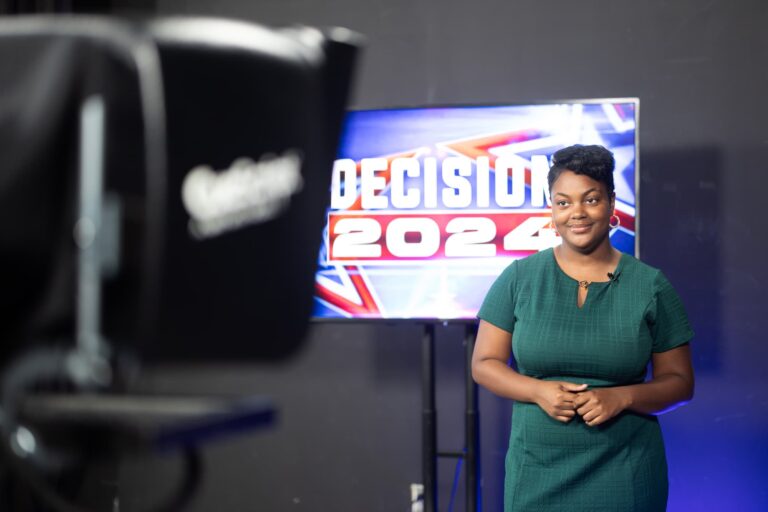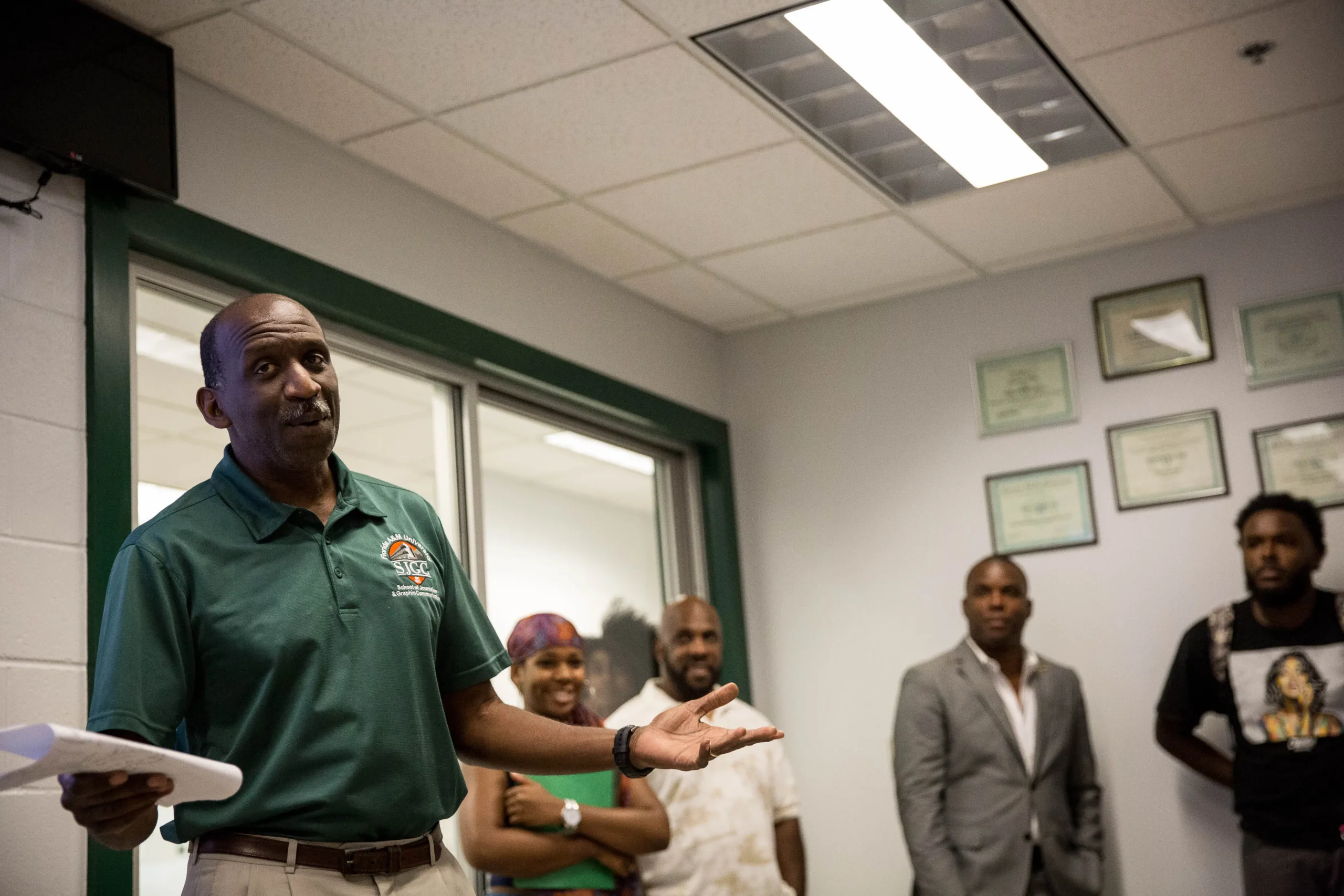
Executive Summary
The School of Journalism & Graphic Communication (SJGC) provides a forward-thinking education that prepares students for immediate and long-term career success. The diverse faculty—62% women, 38% men, and predominantly African American or people of color—reflects the Journalism Division’s student population and HBCU mission. Sixty-nine percent of faculty are tenured or tenure-track, focusing partly on research, while 31% are teaching faculty with significant professional experience dedicated to course instruction.
Faculty Breakdown by Rank, Gender, and Race
Fall 2023 – Spring 2024
| Rank | Number | Men | Women | Black | White | Asian | Other |
|---|---|---|---|---|---|---|---|
| Professor | 4 | 2 | 2 | 3 | 1 | 0 | 0 |
| Associate Professor | 4 | 1 | 3 | 3 | 1 | 0 | 0 |
| Assistant Professor | 1 | 0 | 1 | 0 | 0 | 1 | 0 |
| Instructor | 1 | 1 | 0 | 1 | 0 | 0 | 0 |
| Visiting Instructor | 3 | 1 | 2 | 3 | 0 | 0 | 0 |
Faculty is comprised of five men and eight women. Faculty of color represent 85% of the unit’s full-time faculty for the fall 2023 and spring 2024 academic year. Women make up 62% of the school’s full-time faculty; 38% of full-time faculty are men.
Faculty Breakdown by Degree and Experience
Fall 2023 – Spring 2024
| Rank | Total | Doctoral Degree | Master of Fine Arts | Master’s Degree | Academic Experience (Mean Years) | Professional Experience (Mean Years) |
|---|---|---|---|---|---|---|
| Professor | 4 | 2 | 1 | 1 | 23 | 24.5 |
| Associate Professor | 4 | 3 | 0 | 1 | 21 | 22.5 |
| Assistant Professor | 1 | 1 | 0 | 0 | 21 | 8 |
| Instructor | 1 | 0 | 0 | 1 | 13 | 35 |
| Visiting Instructor | 3 | 1 | 0 | 2 | 12.3 | 15 |
Sixty-nine percent of the faculty are tenured or were on the tenure-track with a portion of their work dedicated to research, while 31% of the unit’s faculty are teaching faculty, at the instructor rank, with significant professional experience and primary duties focused on course instruction.
Please respond to each of the following instructions:
- Describe how the unit selects full-time and part-time faculty and instructional staff.
Full-time tenure-track faculty and instructors are selected through a national search. Ads are placed in academic and professional job publications and on the FAMU website. The dean appoints a search committee, which includes an undergraduate student.
The committee reviews all applications, selects two to three finalists for interviews, and presents unranked recommendations to the dean, who makes the final decision. Interviews may be conducted virtually or in-person. The search and screen committee process involves informing committee members of such things as the Florida Sunshine Law and the University’s obligations as an Equal Opportunity Employer and the noticing of meetings.
Visiting and part-time faculty are appointed by the division director as needed. Visiting professors are granted one-year contracts, with a maximum tenure of four years. The Journalism Division utilizes a dedicated search committee for regular faculty positions, whereas the dean assembles different committees for specific roles such as the associate dean, the Knight Chair, and recruiter positions.
- Describe the university and unit expectations of faculty members in teaching; research; creative and professional activity; and service. Describe the process for the award of tenure, promotion, reappointment, and salary. (Provide digital access to relevant faculty handbook sections and any supplementary promotion and tenure criteria and procedures adopted by the unit. Please provide specific page numbers.)
According to Florida A & M University (FAMU) policies, faculty members are expected to demonstrate excellence in all three areas of teaching, research, and service, with evaluations focusing on factors like course organization, effective delivery of content, student engagement, quality of research, creative endeavors, and contributions to the university and professional communities.
The unit’s teaching, research, and service expectations for tenure-earning and tenured faculty seeking promotion are guided by university policy and are outlined in the unit’s tenure and promotion guidelines. Tenure-earning and tenured faculty seeking promotion must provide evidence of teaching, research, and service. Instructor candidates seeking promotion are required to demonstrate dedication and vigor for exemplary teaching, continuous engagement in professional development activity, and active participation in significant service to the University, the academy, and the community at large.
There is a multi-step process for tenure and promotion that includes:
- Faculty candidates submit an application and supporting documentation online through Interfolio.
- The college or school tenure and promotion (T&P) committee reviews candidates’ dossiers and submits recommendations to the dean. The dean reviews all materials and sends a recommendation to Academic Affairs. The university-wide T&P committee reviews the candidates and submits recommendations to the provost.
- The provost submits tenure recommendations to the president, who then submits them to the Board of Trustees (BOT) for review and decisive action. The president or designee notifies applicants of the BOT’s action.
Faculty promoted from Assistant Professor to Associate Professor receive a 12% annual salary raise. Those promoted from Associate Professor to full Professor receive a 15% raise in their yearly salary.
Starting in the 2023-2024 academic year, tenured faculty began participating in a post-tenure review (PTR) process. The Florida Board of Governors adopted Regulation 10.003 requiring Florida State University System institutions with tenured faculty to adopt a post-tenure review process by October 16, 2023. Tenured faculty are to receive a PTR review of five years of performance in the fifth year following their last promotion or last PTR review, using the University’s guidelines and the unit’s PTR criteria.
Link for Post Tenure Review
- Describe professional development programs, workshops in teaching, or other methods used to stimulate and encourage effective teaching.
Throughout the years, faculty has continuously participated in workshops offered by the University’s Teaching and Learning Center for professional development, teaching, and other pedagogy enhancements. Due to the 2020 pandemic, increased attention was given to professional development to ensure faculty had the skills necessary to teach and engage with students online. As such, most faculty in public relations and journalism have at a minimum undergone training through FAMU’s Office of Instructional Technology (OIT) for certification of online education. OIT not only provided online course instruction and certification for faculty to teach online, but they also provided resources to students who needed them to ensure they were properly equipped for online classes. Since Fall 2023, the unit’s technology department has encouraged faculty to train with Adobe, Google, and Apple with the incentives of earning digital badges and skills to implement technology in classroom teaching. The unit also worked with companies, such as Muck Rack and NUVI (a social media and internet monitoring program) in 2020 and 2023 respectively, to provide faculty with small groups or one-on-one training.
In Spring 2024, the Center awarded a one-year scholarship to a public relations faculty member to conduct an intervention study to advance pedagogy and learning outcomes. Another faculty was awarded a Dow Jones News fellowship to participate in the Multimedia Training Academy in 2022. In addition, the unit’s Curriculum Committee provided professional development workshops to faculty teaching courses in the new curriculum. The first workshop took place in Fall of 2022 to cover new courses in broadcast journalism, and the second in Fall of 2023 to cover public relations courses. Faculty members also benefited from attending professional and academic conferences, including the Public Relations Society of America (PRSA), the Broadcast Education Association, and AEJMC, for professional development.
- Describe the normal workload for a full-time faculty member. Explain how workloads are determined. If some workloads are lighter or heavier than normal, explain how these variations are determined.
Tenure-track and tenured professors are assigned a 3/3 teaching load each semester, plus non-credit generating research, and/or services to the school; whereas other schools and departments within the University have 4/4 teaching loads. A 3/3 teaching load allows faculty time for research and service. Instructors may have a 3/3 teaching load, providing them time for more service in the division or a 4/4 load depending on instructional needs.
The teaching load and the non-credit services, together, equate to one full-time equivalency (FTE)—i.e., each three-credit hour course taught equals a 20 percent effort (60% total), and 40 percent is devoted to services such as academic administrative support, other instructional efforts, public/institutional service, etc.
Occasionally, situational circumstances require variations in faculty workload. For instance, high enrollment numbers in core major courses may necessitate additional sections, resulting in some faculty members teaching a 4/4 load instead of the usual 3/3. These faculty members typically receive overload pay as compensation. Conversely, due to light enrollment, some faculty may only teach two classes, necessitating fewer class sections. These faculty members are often assigned additional non-credit generating activities to ensure their total effort remains at 100 percent, or one FTE. New tenure-track faculty members might be granted a course release at the start of their employment to promote early research productivity.
Instructors or visiting instructors assigned to teach performance-based or experiential-learning courses such as the PR agency or Advanced TV News may have alternative teaching loads due to the additional contact hours required. Contact hour equivalencies are established for all activity other than classroom instruction. Examples include: Additional hours worked with a PR client beyond 180 minutes of class time in a week or the hours to supervise the live TV newscasts 3 times a week.
- Demonstrate that full-time tenured, tenure-track and fixed-term faculty have taught the majority of core and required courses for the three years before the site visit. If full-time faculty have not taught and are not teaching the majority of core and required courses, the unit should explain how its staffing plan accomplishes the goal of reserving the primary responsibility for teaching to the full-time faculty.
Percentages of core and required courses taught by full-time tenured, tenure-track and visiting faculty for the past three years:
| Fall 2021 | 85% Full-time Faculty, 33 out of 39 courses | 15% Part-time Faculty out of 39 courses |
| Spring 2022 | 79% Full-time Faculty, 23 out of 29 courses | 21% Part-time Faculty, 6 out of 29 courses |
| Fall 2022 | 67% Full-time Faculty, 26 out of 39 courses | 33% Part-time Faculty, 13 out of 39 courses |
| Spring 2023 | 71% Full-time Faculty, 25 out of 35 courses | 29 Part-time Faculty, 10 out of 35 courses |
| Fall 2023 | 74% Full-time Faculty, 29 out of 39 courses | 26% Part-time Faculty, 10 out of 39 courses |
| Spring 2024 | 78% Full-time Faculty, 29 out of 39 courses | 22% Part-time Faculty, 10 out of 39 courses |
2023-24 school year: 76% of courses taught by full-time faculty (76 courses total, 58 taught by full-time faculty) (Includes Fall 2023 and Spring 2024 only).
2022-23 school year: 69% of courses taught by full-time faculty (74 courses total, 51 taught by full-time faculty) (Includes Fall 2022 and Spring 2023 only)
2021-22 school year: 82% of courses taught by full-time faculty (68 courses total, 56 taught by full-time faculty) (Includes Fall 2021 and Spring 2022 only)
The trend continued for Fall 2024, where 75% of courses were taught by full-time faculty.
To support the teaching of core and new courses, the unit recently hired two faculty – Instructor for Public Relations and Garth Reeves Eminent Scholar and Instructor in Digital Journalism. Current searches are underway for an Endowed (Knight) Chair, Instructor for Broadcast Journalism and Assistant Professor for Visual Storytelling. With the recent retirement of an Associate Professor, the unit expects to advertise for another full-time faculty position in 2025.
- Describe the unit’s processes and criteria for evaluating the performance of full-time and part-time faculty and instructional staff, including teaching evaluations and faculty evaluations. Use a digital format to provide access to any course evaluation forms, peer review forms or other documents used in evaluations.
The Journalism Division faculty receive an annual review in the spring semester. Faculty are evaluated in four areas: teaching effectiveness, research and creative activity, performance in service and other university duties.
As part of the review, faculty members are expected to provide concrete evidence to support their accomplishments in each area, such as published articles, presentations, grant awards, student evaluations, certifications, and committee appointments.
Faculty complete a self-evaluation form and meet with the dean, associate dean, or division director for discussion. This self-evaluation process allows the faculty to provide input on their research, teaching, and service performance for the academic year. It also allows tenure-track and tenured faculty to collect evidence and prepare materials for tenure and promotion.
The final evaluation includes comments from the faculty member and supervisor and signatures of both parties, plus the dean.
| Performance Evaluation Areas | Specific Components and Criteria |
|---|---|
| Teaching Effectiveness | 1. Organization and planning of courses 2. Evidence of careful preparation (course outlines, syllabi) 3. Ability to make courses challenging, inspire interest and thought 4. Quality of scholarship and professionalism 5. Professional classroom decorum and atmosphere 6. Punctuality with attendance, schedule, grading, and reports 7. Accessibility, openness to questions, maintenance of office hours 8. Fairness of examinations and student evaluations |
| Research and Creative Ability | 1. Presentation of papers/creative works at professional meetings 2. Published papers or articles in professional journals/books 3. Recognized creative work (music, paintings, design, etc.) 4. Ongoing research or creative endeavors 5. Development of research projects or proposals |
| Performance in Service | 1. Departmental, college, and university committees 2. Contribution to faculty meetings and program activities 3. Membership and contribution to professional organizations 4. Professional development, continuing education, certification 5. Community activities on local, state, national, or international level |
| Other University Duties | 1. Academic advising 2. Counseling/advising clubs/organizations, directing interns 3. Administrative duties |
Link for Faculty Evaluation Form/Criteria
Link for A&P and Non-Unit Faculty Evaluation Form
- For the grid that follows: Define the group of faculty whose work is included in this section and state time restrictions used to incorporate activities of faculty who were not employed by the unit during the review period (for example, new faculty and retired faculty).
Using the grid below, provide counts of the unit’s overall productivity in scholarship during the review period by activity; first the totals for the unit as a whole and then for the individuals who produced these totals, broken down by academic rank. The chart should provide a snapshot of scholarship activity within the unit during the review period. Therefore, the grid should capture relevant activity by all full-time faculty only while at the accredited unit. Provide the total number of individuals in each rank in place of the XX. Adapt the grid to best reflect institutional mission and unit policies and provide a brief narrative.
| Scholarship, Research, Creative and Professional Activities | Total from Unit* | |||||
| Full Professors (4) | Associate Professors (4) | Assistant Professors (1) | Other Faculty** (4) | Totals (13) | ||
| Awards and Honors | 1 | 0 | 1 | 0 | 0 | 1 |
| Grants Received Internal | 2 | 0 | 0 | 2 | 0 | 2 |
| Grants Received External | 2 | 1 | 1 | 0 | 0 | 2 |
| Scholarly Books, Sole- or Co-authored | 0 | 0 | 0 | 0 | 0 | 0 |
| Textbooks, Sole- or Co-authored | 0 | 0 | 0 | 0 | 0 | 0 |
| Books Edited | 0 | 0 | 0 | 0 | 0 | 0 |
| Book Chapters | 15 | 11 | 1 | 2 | 0 | 14 |
| Monographs | 0 | 0 | 0 | 0 | 0 | 0 |
| Articles in Refereed Journals | 12 | 8 | 1 | 3 | 0 | 12 |
| Refereed Conference Papers | 14 | 6 | 0 | 8 | 0 | 14 |
| Invited Academic Papers | 0 | 0 | 0 | 0 | 0 | 0 |
| Encyclopedia Entries | 2 | 0 | 0 | 2 | 0 | 2 |
| Book Reviews | 0 | 0 | 0 | 0 | 0 | 0 |
| Articles in Non-refereed Publications | 2 | 0 | 0 | 0 | 0 | 2 |
| Juried Creative Works | 0 | 0 | 0 | 0 | 0 | 0 |
| Non-juried Creative Works | 2 | 0 | 2 | 0 | 0 | 2 |
| Academic and Professional Conference Presentations (Non-refereed) | 0 | 0 | 0 | 0 | 0 | 0 |
| Panel Presentations at Refereed Conferences | 25 | 21 | 1 | 3 | 0 | 25 |
| Other (please specify)*** | 13 | 5 | 3 | 5 | 0 | 13 |
**Other faculty includes all full-time faculty who do not hold listed ranks, such as instructors and others on term appointments. Many faculty in this category may hold teaching appointments without significant scholarship, research, or creative requirements.
***Other represents non-refereed conference panels, moderating academic seminars, writing commentary and opinions in publications, and speaking at professional conferences.
During the review period, in the Division of Journalism six journalism faculty served as instructors. Additionally, seven tenured and tenured-track faculty (including two administrators) published a total of 12 peer-reviewed scholarly articles in refereed journals such as Health Communication, Journal of Health Psychology, Journal of Community Psychology, Journalism and Mass Communication Educator, International Journal of Communication, Howard Journal of Communication, and The China Review. Fifteen book chapters and two entries in the International Encyclopedia of Health Communication have been published. The Division faculty produced 14 refereed paper presentations to conferences, including the International Communication Association, Association for Education in Journalism and Mass Communication, Broadcasting Education Association, Society of Behavioral Medicine, and Kentucky Conference on Health Communication. There are also several ongoing research projects and papers in health communication, post COVID mental health, online civility, media framing and visual communications.
In the last six years, an assistant professor (Dr. Hsuan Huang) was awarded two grants totaling $15,000 from the University for a year-long research project on COVID-19 Vaccination among young Black adults and a SoTL intervention study on teaching and learning using artificial intelligence (AI). An associate professor (Dr. Valerie White) was awarded a $7,500 Solution Journalism grant to enhance the practice and teaching of Solution Journalism.
Furthermore, the Journalism Division faculty have participated in 25 refereed conference panels. professional and creative activities. The “Other” category in the grid includes participating/chairing in non-refereed conference discussion panels, moderating academic seminars, writing commentary and opinions in publications, and speaking at professional conferences.
In Spring 2024 and Fall 2025, Dean Lowe received service grants from the Henry Luce Foundation and the MacArthur Foundation totaling $140K for a HBCU News Deserts project to create a strategy for local news collaboration.
During the 2020-2021 and 2021-22 school years, there was a lull in scholarly activity due to the pandemic as faculty focused on transitioning to an online modality and teaching remotely. However, there has been steady improvement in overall scholarly output compared to the previous full report in 2012-2018.
The most growth related to research output is reflected by an increase in peer-reviewed journal articles, refereed conference presentations, and book chapters/encyclopedia entries by full and tenure-track professors. The number of peer-reviewed publications and external conference presentations doubled in 2022-2023 compared to the previous year.
(Link for Academic Scorecard in Evidence Materials for Standard 5.)
Hiring
The Journalism Division advertised three faculty positions for the 2024-2025 academic year. Among them are two journalism instructor positions, one public relations instructor position, and one tenure-track assistant professor position to fill vacant positions from the departures of three tenure-track and tenured professors and to meet the teaching demands of the new Journalism and PR curriculum. While these hirings will help fulfill the unit’s immediate instructional needs, the unit is monitoring the implications on the unit’s research and scholarly productivity. The two new hires as of Fall 2024 are both at the instructor level with a master’s degree. One of the new instructors is pursuing a Ph.D.
Workload and Scheduling
Tenured and tenure-track faculty, along with instructors and visiting instructors, all handle a 3/3 teaching workload. This load provides for a division of 50% teaching, 30% research and 20% service for tenured and tenure track. The instructors and visiting instructors are not required to engage in research, scholarly, professional, or creative activities. However, they are expected to serve on committees and support school initiatives. They typically serve 60% teaching and 40% service. The Journalism Division director manages course scheduling each semester.
Infrastructures for Research
To align with FAMU’s 2022-2027 strategic plan, specifically Priority 2 on Academic Excellence and the pursuit of Carnegie Classification of Research 1 status, enhancing research infrastructure is essential. Key areas include ensuring consistent course assignments, accommodating faculty schedules, and offering incentives and opportunities for course release to afford research faculty adequate time for their projects. Additionally, faculty require further resources and support, such as small or seed grants, recognition, rewards, and the promotion of collaborations both within and outside the institution.
- List in a separate digital file the scholarly, research, creative and professional activities of each member of the full-time faculty during the review period. Limit to 10 per faculty member through the review period. The unit has the option of providing a complete list in an additional separate digital file. (Full-time faculty refers to those defined as such by the unit.) If including faculty who have since left the unit, please note the departure. Professional service activities should be reported in Standard 8.
Link for Faculty Research By Name
- Describe the institution’s policy regarding sabbaticals, leaves of absence with or without pay, etc. List faculty who have taken sabbaticals or leaves during the review period. Give one-sentence descriptions detailing the academic achievements of each sabbatical.
The unit’s sabbaticals and leaves of absence policy is consistent with the University’s Collective Bargaining Agreement regarding sabbatical and professional development leave. Sabbaticals and professional development leaves are granted to increase a faculty member’s value to the University through enhanced opportunities for professional renewal, planned travel and study, research, writing and other professional experiences. To be eligible for the sabbatical leave program, a faculty employee must be full-time and tenured, with at least six (6) years of full-time service in the State University System.
Faculty can apply to take a semester-long sabbatical and professional development leave with full pay or a one-year long sabbatical and leaves of absence with half pay. Faculty approved for leave must agree to return to the University for at least one academic year after. Upon return, faculty must provide a written report of accomplishments to the dean and the Office of the Provost. No SJGC faculty member has taken a sabbatical or professional development leave of absence during the review period. However, one faculty member has been granted professional development leave for spring 2025.
Link for Professional Development and Career Faculty Resources
- Describe travel funding, grant support, or other methods or programs the unit uses to encourage scholarship, research, and creative and professional activity. List faculty who have taken advantage of those programs during the review period.
The unit supports faculty scholarship, research, and creative and professional activity through its Knight Faculty Development Fund. This is an endowed fund established by the Knight Foundation at FAMU in 1999.
The fund covers domestic and international travel to conferences for presentations and professional development; workshops/seminars; professional memberships; and direct costs for research and projects, including software, equipment, and services. The fund also supports fellowships that allow faculty to embed with industry partners – shadowing, collaborating, and producing relevant outcomes.
Listed below are the faculty who have used the fund during the review period.
- Clarence Fowler (2023-2024, 2024-2025)
- Hsuan Huang (2022-2023, 2023-2024, 2024-2025)
- Leah Hunter (2022-2023)
- William Jiles (2023-2024, 2024-2025)
- Mira Lowe (2022-2023, 2023-2024, 2024-2025)
- Felicia McGhee (2023-2024, 2024-2025)
- Deborah Thigpen (2023-2024)
- Venise Toussaint (2023-2024)
- Jeffrey Wilkinson (2022-2023, 2023-2024, 2024-2025)
The unit also encourages the faculty to utilize the Florida A&M University (FAMU) Faculty Travel Grant (FTG) Program, an initiative also designed to financially assist faculty travel to present research findings.
